Kotka 作者: 来源: 发布时间:2021-10-15
一、所属省或是州,具体位置,人口,面积
Kotka is a town in the southern part of the Kymenlaakso province on the Gulf of Finland. Kotka is a major port and industrial city and also a diverse school and cultural city. The neighboring municipalities of Kotka are Hamina, Kouvola and Pyhtää. Kotka belongs to the Kotka-Hamina subdivision, and with Kouvola, Kotka is one of the capital center of the Kymenlaakso region.
Kotka is located on the coast of the Gulf of Finland at the mouth of Kymi River and it is part of the Kymenlaakso region in southern Finland. The most important highway in Kotka is Finnish national road 7 (E18), which goes west through Porvoo to Helsinki, the capital of Finland, and extends east to St. Petersburg, Russia. The Port of Kotka is a major Finnish sea port that serves both the foreign trade of Finland and Russia. The municipality is officially unilingually Finnish, with 89.8% being native Finnish speakers, 1% Swedish, and 9.3% speaking some other language.
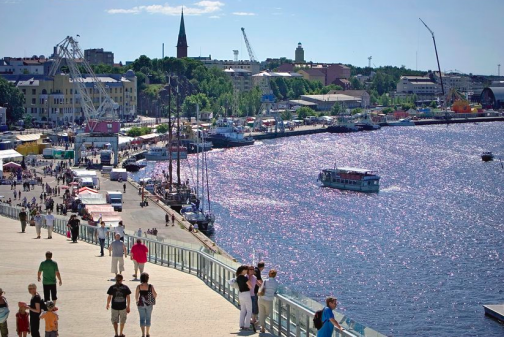
二、自然地理
1.地理条件
The center of Kotka is located on Kotkansaari. Another important center is the former church village of Kymi parish and the center of Karhula town, which now belongs to the Karhula and Helilä districts. The most significant apartment building suburbs are Karhuvuori in the west and Sunila in the east. Kotka's city center is divided into town districts. Outside the city center, there are mostly rural, unplanned villages. Kotka has a land area of 277.77 square kilometers, of which 5.82 square kilometers are inland waterways. The sea area is 671.99 square kilometers. The cityscape of Kotka is characterized by the broken coast of the Gulf of Finland with its archipelagos and the mouths of the Kymijoki River. The largest of the islands are Mussalo, Kirkonmaa, Kuutsalo and Kotkansaari. The outer archipelago of the Gulf of Finland is the Haapasaari archipelago. Hovinsaari and Kolkansaari are peninsulas protruding into the sea between the mouths of the Kymijoki River, which can also be considered as islands, as the Kymijoki River separates them from the mainland.
The Kymijoki River flows into the sea as three branches in the city area, listed from west to east by Langinkoskenhaara, Huumanhaara and Korkeakoskenhaara. Hovinsaari lies between Langinkoski and Huumanhaara and Kolkansaari between Huuman- and Korkeakoskenhaara. There are several rapids in the Kymijoki area in the Kotka area. The largest free-flowing rapids are Pernoonkoski, Langinkoski, Siikakoski and Kultaankoski. Hydropower plants have been built in Korkeakoski and Koivukoski.
There are only two small lakes in Kotka, about one kilometer in diameter, and some ponds about 300 meters in diameter. Lake Laajakoskenjärvi next to the Pernoonhaara of the Kymijoki River was originally a river cove. As a result of the clearing and straightening of Laajakoski and the consequent lowering of the water level, it is now separated from the river by a narrow tributary. Lake Rapakivenjärvi on the border of Kotka and Kouvola is an almost overgrown lake, located along the branch of the ancient Kymijoki River that led to the present Nummenjoki River. Laajakoskenjärvi and Rapakivenjärvi belong to Natura 2000 areas.
The highest point of Kotka is Suurivuori, located near the Hamina border, at an altitude of 87 meters above sea level. Other high points are the Kymi airport area (about 72 meters) and Pernoon Haukkavuori (69.1 meters). The bedrock is mostly rapa rock. On the east side of the Kymijoki River there is a partly intermittent longitudinal ridge. Along the Kymijoki and Nummenjoki rivers there is flat clay and former marshes that have been cleared into fields. The most significant of the natural marshlands is Mustanjärvensuo, located near the border with Pyhtää, which belongs to Valkmusa National Park. The climate is particularly affected by the Gulf of Finland off the coast, as a result of which the southern parts of the city have features of a maritime climate. In the northern parts of the city, the climate is already much more continental.
2.交通情况
There is a railway connection from Kotka to Kouvola, completed in 1890. The passenger port for shipping is in Kantasatama, and in addition, connecting vessels to the archipelago leave from the Sapokanlahti pier, for example to Pyhtää's Kaunissaari. Kymi Airport is a small plane in the northern parts of the city.
The city is located along Highway 7, E18, through which the distance to Helsinki is about 130 kilometers. Local traffic in Kotka is currently handled only by Pohjolan Liikenne, which first bought Karhula's bus traffic from Onni Vilkas Oy after Onni Vilkka's death and then Mussalo-Karhuvuori's traffic rights in November 2007 from Jyrkilä Transport Company, which will, however, continue to operate charter traffic. In addition, Savonlinja-Yhtiöt, Henkilöliikenne Heino Oy and Liikenne Vuorela operate service lines and standard regional and long-distance services in Kotka. In 2011, the Port of Kotka merged with the Port of Hamina to become the Port of Hamina-Kotka, which is the largest public port in Finland. Even before its merger, the Port of Kotka was Finland's largest export port.
三、经济发展和规模
Kotka's three largest employers at the beginning of 2008 were the City of Kotka, the Kymenlaakso Hospital District and Steveco. The largest industries in 2004 were social services (31.7%) and industry (21.9%). In 2006, the city's total expenditure was just over EUR 370 million and municipal tax revenue amounted to EUR 141.3 million. with an income tax rate of 18.75%. At the end of 2015, the unemployment rate in Kotka was 22.2 per cent, which is one of the highest and largest cities in Finland. In 2005, the unemployment rate in Kotka was 14.4% and in 2006 12.9%. In 2010, the city's relative unemployment rate started to rise and at the end of 2012 the rate was 17.1%.
Evaluation report 2019 The financial statements, the evaluation report and the staff report will be published after consideration by the discharge authority. The consolidated financial statements include the balance sheet, income statement, cash flow statement and the information attached to them, as well as a comparison of budget implementation and the report of the Board of Directors.
The budget for the following year will be published by the end of the year. The budget includes a financial plan for three years. The budget and plan approve the operational and financial objectives of the municipality and the group of municipalities.
https://www.kotka.fi/kotkan-kaupunki/talous/
https://www.kotka.fi/wp-content/uploads/2020/01/Talousarvio-2020.pdf
四、产业特点/重点项目
The largest employers in the city of Kotka in January 2010.
Employer Employees
City of Kotka 3,523
Kymsote 940
Steveco 888
Stora Enso 562
Sulzer Pumps 535
Cooperative Circle 494
Ahlstrom 326
Ekami 296
Vaasa 287
Andritz 245
Paper industry
There are two paper mills, one board mill and two pulp mills in Kotka.
Sonoco, Karhula board mill (formerly Karhula Osakeyhtiö and Ahlström)
Kotkamills, Kotka paper mill and pulp mill (formerly Enso Gutzeit, Enso Group and Stora Enso)
Haarla Oy, Hovinsaari paper mill (closed in 1999)
Stora Enso, Sunila Oy's pulp mill
Halla Oy, Halla pulp mill (closed)
The port of Mussalo has bulk, liquid and container terminals as well as a large logistics area.
The main port is a multi-purpose port that is mainly focused on lolo-type traffic. The port is divided into a commercial and a cultural port. The Vellamo Maritime Center is located in the main port, where the Finnish Maritime Museum and the Kymenlaakso Museum operate. Next to the marine center Vellamo is the icebreaker Tarmo on the pier. The Finnish Wooden Boat Center is also located in the main port area. Hietanen has focused on ro-ro traffic. The importance of the port of Hietanen in Kotka has increased sharply with the growth of passenger car transit traffic to Russia.
Kotka also has ports other than those belonging to HaminaKotka Satama Limited Liability Company:
The Port of Sunila is a port jointly owned by Sunila Oy and HaminaKotka Satama Oy, The Port of Halla is a port owned by UPM-Kymmene Corporation on the island of Halla, Pohjolan Voima Oy's port in Mussalo. Kuusinen harbor on Kuusinen island. Kotka archipelago's connecting vessel traffic, fishing port and fairway vessel port. Sapokka. Connecting vessel traffic in the Kotka archipelago. Guest harbor. The area of the former Puistola oil port now houses the Catherine Marine Park.
五、风景名胜,景点( attractions)
1. Church of St. Nicholas
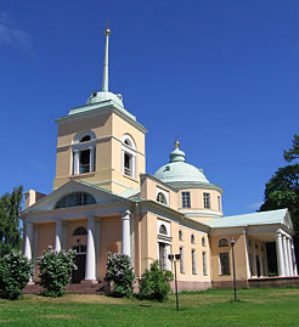
St. Nicholas Church is the main church of the Kotka Orthodox Parish in Kotka. The church was built between 1799 and 1801 according to the drawings of the architect Jakov Perrin.The building is a notable representative of Russian neoclassicism in Finland. The Church of St. Nicholas dates back to the time of the fortress town of Ruotsinsalmi, when the Russians built the Ruotsinsalmi – Kyminlinna double fortress in the Kymi area and Kotkansaari became a fortress town. The church is the oldest building in present-day Kotka. It is surrounded by Isopuisto.
The church was consecrated in honor of St. Nicholas the Miracle Worker, the Archbishop of Miri. St. Nicholas is one of the most respected saints of the Orthodox Church, he is the patron saint of travelers, sailors and fishermen, among others. Patron of the Russian Empire and many other countries and cities.
2.Karhula Manor
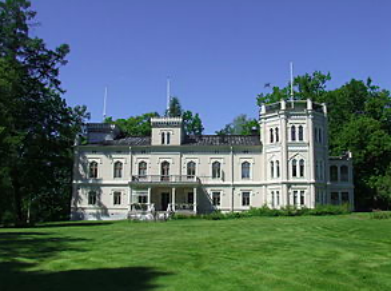
Karhula Hovi, or Karhula Manor, is a manor-like building located along the Kymijoki River in Karhula, Kotka. Its construction began in 1887 and was designed by architect Carl Ricardo Björnberg, the site of the former Karhula Court was originally a farmhouse owned by Hamina merchants in the 17th and 18th centuries. In the mid-19th century, the Nordmann and Londén family were the owners. In 1873 the estate ended with Knut Hjalmar Cassel, who served as secretary to the Royal Court Marshal's Office and was married to wealthy Adelina Sundman of Loviisa. In 1874, Cassel established a two-frame steam sawmill in Karhula, which went bankrupt in 1881 and ended up in the ownership of William Ruth. In 1888 he married Fanny Standertskjöld. Construction of the current building began in 1887 and was completed in 1892. The architecture of the stone building represents Neo-Renaissance and Gothic, and it mimics a French noble castle. The area of the court is 917 m² and there are 30 rooms.
After the death of William Ruth in 1913, the Fanny and William Ruth Donation Fund was established, which was intended to be used for the benefit of small farmers in Finland. A. Ahlström Oy bought Karhula Oy's factories in 1915 and Hovi was part of the deal. The CEOs and property managers of Karhula Oy, which merged with Ahlström, lived in the house until 1966, after which it has been used as a representative office. The building has also housed the NEXT Hotel Karhulan Hovi. Kartanohotelli Karhulan Hovi, which is operated by Kotkan Saaret Oy, which is owned by a family company in Kotka, now operates in the area of the manor.
3. Catherine Marine Park
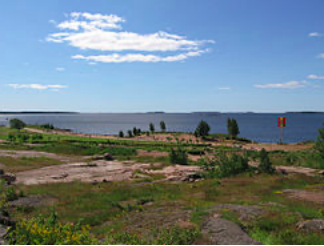
Catherine Marine Park is a park in Kotka, in the southern parts of Kotkansaari, on Katariinanniemi. In the area of the park there are the ruins of Fort Katarina, the main fortress of the Swedish Strait Sea Fortress. Fort Katarina is surrounded by dry sand and cliffs. Behind the fortification area is Katariina's alder grove, which represents the original grove nature that has become rare on Kotkansaari. The alder grove was pacified in 1964. The marine park was chosen as the 2012 environmental structure. It has also been awarded the Trend Award by the European Landscaping Association.
六、历史文化
1.历史
The earliest settlements in the present-day Kotka area belong to the comb-ceramic culture of the Stone Age. At that time, the sea level was about 20 meters higher than at present, and the current shores of the Kymijoki and Nummenjoki rivers in the Kotka area have been bays. Habitats have been found on the shores of these ancient bays in Laajakoski, Juurikorvi and Ylänummi. The residence, which belonged to the later hammer ax culture, has been found in Juurikorvi, and loose finds belonging to the culture have also been found elsewhere. Bronze Age mounds, or hiiden heaters, are a well-known group in the Höyterinpohja area of Östring Bay between Itäranta and Kaarniemi. The area also has rare Bronze Age or ship or boat-shaped rock deposits during the Bronze Age or the turn of the Bronze and Iron Ages in Finland. One of the tombs in the area is dated to the Early Iron Age. The eastern mouth of the strait between Kuutsalo and Kirkonmaa has sometimes been thought to be the overnight port of the Viking East. Pirköyri Island, located next to Tiutinen, may have been a trading place during the Viking Age. After the Baltic Sea region came under German Hanseatic traders in the late 12th century, trade links to the south on the northern shore of the Gulf of Finland intensified.
The intensified trade in the early Middle Ages and the salmon and whitefish rapids of the Kymijoki River caused strong settlement activity in the Kymijoki estuary. The significant settlement period in the mouths of the Kymijoki River is considered to have begun in the early 13th century. Based on place and personal names, the population that moved to the area was mostly of Häme origin, but the population was also Savo and Karelian. After the construction of Vyborg Castle in 1293, the Kymijoki estuary became annexed to the Swedish Empire and Vyborg Castle County. The emergence of Swedish-speaking settlements in the area dates back to the early 14th century, when Swedish settlers moved to the archipelago and the coast. The right of Tallinn's German Hanseatic merchants to trade freely in the mouths of the Kymijoki and Nummenjoki rivers was limited in 1336, when Peter Vyborg, Vyborg's castle manager, granted them the right to trade in Vyborg, Virolahti and Vehkalahti.
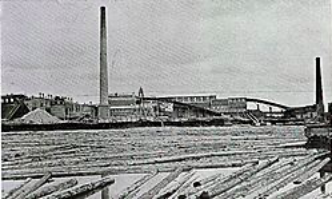
Around 1350, the Kyminkartano was born in the mouth of the Kymijoki River, which was donated to the Vadstena Monastery in 1380 by Bo Joninpoika Grip, a drotype from the Kingdom of Sweden. The Kyminkartano chapel, which belonged to Pyhtää, was built in connection with the manor around 1440. During the time of Gustav Vaasa, the manor became a royal manor in 1556 and became the administrative center of Kymenkartano County Municipality.
On April 16, 1878, the Senate of the Grand Duchy of Finland issued a declaration establishing a city on the island of Kotka from the parish of Kymi, so in 1879 Kotkansaari and the southern parts of Hovinsaari were separated from the municipality of Kymi and the city of Kotka In the city’s first town plan from 1878, the street network was drawn up to be essentially parallel to the streets of the fortress town. The formula was then drawn up as a commonly used grid formula. The completion of the Kouvola-Kotka railway in 1890 strengthened Kotka's development as the most important industrial and port city in its region, past Hamina. After the Second World War, in 1945, a new county was established in Kymen, whose temporary capital was Kotka for a while. The coat of arms of the city of Kotka was designed by Olof Eriksson in 1957.
2. 文化体育
Maritime Centre Vellamo is home to the Maritime Museum of Finland, the Museum of Kymenlaakso, the Coast Guard Museum, Information Centre Vellamo and the Kotka Cultural Centre. In addition to this, the building holds classrooms, seminar rooms, a 200-seat auditorium, Restaurant Laakonki with 100 seats, and Museum Shop Plootu.
The Kymenlaakso museum operates at the Kantasatama Harbour in Kotka, at Maritime Centre Vellamo. The museum building, which has aroused much attention, was designed by the architect Ilmari Lahdelma. The area of operation of the Kymenlaakso museum, which is maintained by the City of Kotka, covers seven municipalities. The museum information services and the work of the regional archaeologist cover the entire region of Kymenlaakso. In building research, the museum serves as a public authority, with duties such as the issuing of opinions in building protection matters. The collections of Kymenlaakso museum have been compiled since the 1920s. Alongside collections of museum items, the museum has an extensive archive of photographs. The collections are located at Metsola in Kotka.
Langinkosken keisarillinen kalastusmaja is a fishing lodge in the valley of River Kymijoki. Kymijoki is one of the biggest rivers in Finland with a drainage basin with 11% of the area of Finland. Alexander III first visited Langinkoski in 1880 as Crown Prince. During his second visit to Langinkoski, he stated that he wanted a small fishing lodge near rapids. Construction of the house began in the summer of 1888 and was inaugurated the following year. The museum is visited annually by about 14,000 visitors a year.
Maretarium Aquarium opened in 2002, is located on Kotka Island, on the shore of the Gulf of Sapokka. It focuses on the presentation of Finnish fish species and water bodies. There are about 60 native and established fish species from Finland. The Maretarium was created in collaboration between the City of Kotka, the University of Helsinki and the Finnish Game and Fisheries Research Institute. In addition to aquariums, there are also facilities for researchers and the nature school. There is also the Maritime Theater, Meri Café Kristina and a souvenir shop. The Church of St Nicholas is located in Isopuisto Park in Kotka city centre. Based on designs by Jakov Perrin, the neoclassical church was constructed between 1799–1801, and it is the oldest building in Kotka today. Facade consists of pillars for three entries, the bell tower and a cross dome.
The local football team is KTP. Founded in 1927, KTP has long, and successful football history. KTP won the Finnish football championship in 1951 and 1952, and Finnish Cup 4 times, in years 1958, 1961, 1967, and 1980. Currently the club plays in the Finnish second league Ykkönen.
七、其他信息
The highest decision-making power of the city of Kotka is exercised every four years by the city council elected by the city residents in municipal elections. The Kotka City Council has 51 members, who elect a 13-member city council and boards. The chairman of the city council is currently Jari Elomaa of the Coalition Party and the chairman of the city board is Sami Virtanen of the SDP. The mayor is Esa Sirviö. There is also a youth council in Kotka, which has representatives on various boards.
八、联系方式
Town manager: Esa Sirviö
Phone:003703575029
Email: kirjaamo@kotka.fi
Address: PL 205, 48101 KOTKA
https://www.kotka.fi
